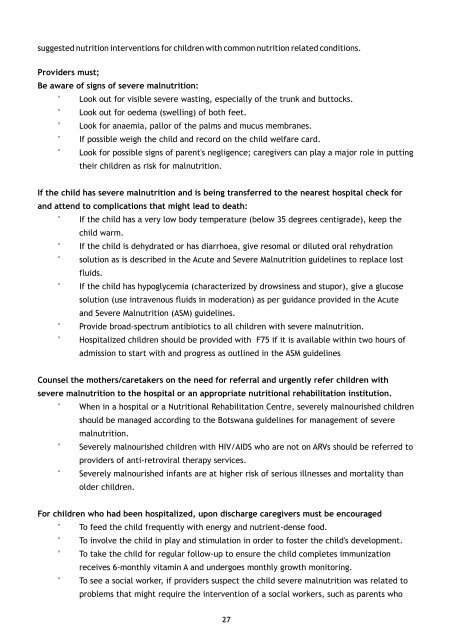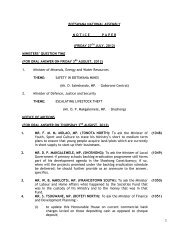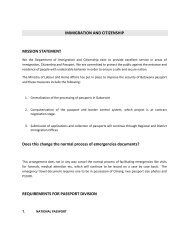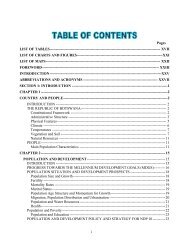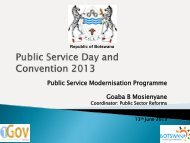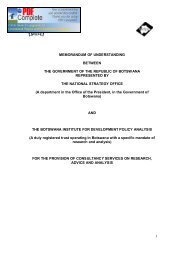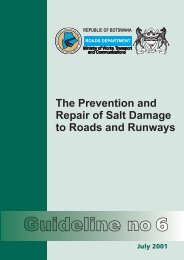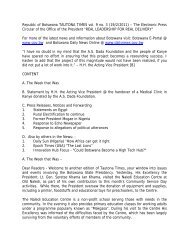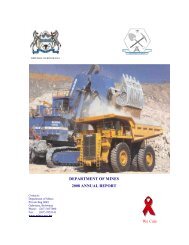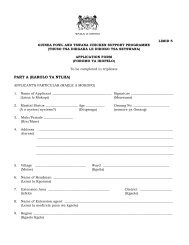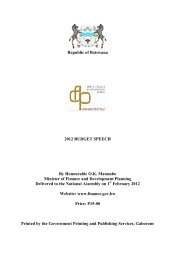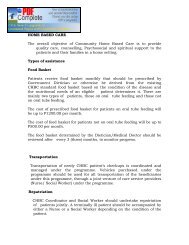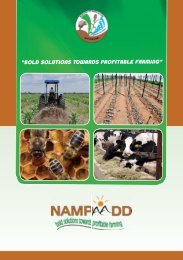National Nutrition and HIV/AIDS Guidelines for Service Providers of ...
National Nutrition and HIV/AIDS Guidelines for Service Providers of ...
National Nutrition and HIV/AIDS Guidelines for Service Providers of ...
You also want an ePaper? Increase the reach of your titles
YUMPU automatically turns print PDFs into web optimized ePapers that Google loves.
suggested nutrition interventions <strong>for</strong> children with common nutrition related conditions.<br />
<strong>Providers</strong> must;<br />
Be aware <strong>of</strong> signs <strong>of</strong> severe malnutrition:<br />
° Look out <strong>for</strong> visible severe wasting, especially <strong>of</strong> the trunk <strong>and</strong> buttocks.<br />
° Look out <strong>for</strong> oedema (swelling) <strong>of</strong> both feet.<br />
° Look <strong>for</strong> anaemia, pallor <strong>of</strong> the palms <strong>and</strong> mucus membranes.<br />
° If possible weigh the child <strong>and</strong> record on the child welfare card.<br />
° Look <strong>for</strong> possible signs <strong>of</strong> parent's negligence; caregivers can play a major role in putting<br />
their children as risk <strong>for</strong> malnutrition.<br />
If the child has severe malnutrition <strong>and</strong> is being transferred to the nearest hospital check <strong>for</strong><br />
<strong>and</strong> attend to complications that might lead to death:<br />
° If the child has a very low body temperature (below 35 degrees centigrade), keep the<br />
child warm.<br />
° If the child is dehydrated or has diarrhoea, give resomal or diluted oral rehydration<br />
° solution as is described in the Acute <strong>and</strong> Severe Malnutrition guidelines to replace lost<br />
fluids.<br />
° If the child has hypoglycemia (characterized by drowsiness <strong>and</strong> stupor), give a glucose<br />
solution (use intravenous fluids in moderation) as per guidance provided in the Acute<br />
<strong>and</strong> Severe Malnutrition (ASM) guidelines.<br />
° Provide broad-spectrum antibiotics to all children with severe malnutrition.<br />
° Hospitalized children should be provided with F75 if it is available within two hours <strong>of</strong><br />
admission to start with <strong>and</strong> progress as outlined in the ASM guidelines<br />
Counsel the mothers/caretakers on the need <strong>for</strong> referral <strong>and</strong> urgently refer children with<br />
severe malnutrition to the hospital or an appropriate nutritional rehabilitation institution.<br />
° When in a hospital or a <strong>Nutrition</strong>al Rehabilitation Centre, severely malnourished children<br />
should be managed according to the Botswana guidelines <strong>for</strong> management <strong>of</strong> severe<br />
malnutrition.<br />
° Severely malnourished children with <strong>HIV</strong>/<strong>AIDS</strong> who are not on ARVs should be referred to<br />
providers <strong>of</strong> anti-retroviral therapy services.<br />
° Severely malnourished infants are at higher risk <strong>of</strong> serious illnesses <strong>and</strong> mortality than<br />
older children.<br />
For children who had been hospitalized, upon discharge caregivers must be encouraged<br />
° To feed the child frequently with energy <strong>and</strong> nutrient-dense food.<br />
° To involve the child in play <strong>and</strong> stimulation in order to foster the child's development.<br />
° To take the child <strong>for</strong> regular follow-up to ensure the child completes immunization<br />
receives 6-monthly vitamin A <strong>and</strong> undergoes monthly growth monitoring.<br />
° To see a social worker, if providers suspect the child severe malnutrition was related to<br />
problems that might require the intervention <strong>of</strong> a social workers, such as parents who<br />
27


